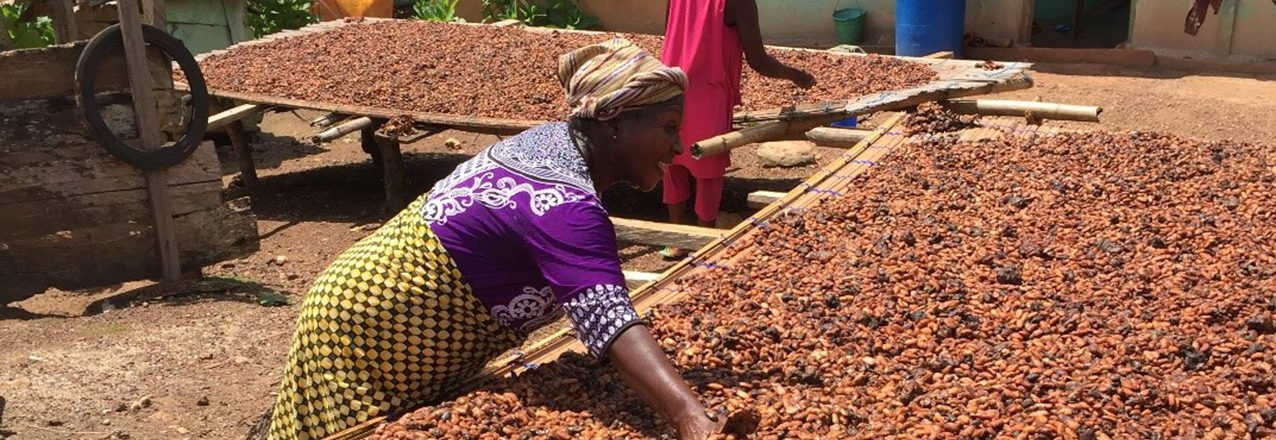Everybody loves chocolate.
The beans that form the basis of chocolate are sourced from tropical cocoa trees, which are grown commercially in only a few developing countries. West Africa alone is responsible for over two-thirds of global production. In these countries, chocolate supports local livelihoods and incomes. But there is a bitter side to the chocolate industry: from the mid-1980s to 2004, global production of cocoa doubled primarily through expansion into naturally forested areas. This is the case in Ghana, the world’s second largest producer of cocoa, where cocoa farms have been driving deforestation and forest degradation, and a significant contributor to the country’s greenhouse gas emissions.
Cocoa is not the only commodity that contributes to tropical forest loss. Since 2014, over 400 businesses have made pledges associated with the New York Declaration on Forests to reduce the impacts of agricultural commodity supply chains on forests and forest communities, whether cocoa, palm oil, soy, or others. The Tropical Forest Alliance 2020 (TFA 2020)—a global public-private partnership between governments, the private sector and civil society—is working with many agribusinesses to support them in their goals to achieve deforestation-free supply chains.
One of the important challenges in making supply chains deforestation-free, and thus more sustainable, is land rights. Farmers who do not have secure land and tree rights have few incentives to invest in sustainable agriculture. Recognizing this, TFA 2020 is addressing constraints related to land rights, agricultural land use, and landscape-level planning and management in places like Ghana.
The Government of Ghana has pledged to reduce forest loss and cut greenhouse gas emissions by 45 percent in the cocoa forest landscape by 2030. To help make this a reality, Ghana is participating in the Forest Carbon Partnership Facility and proposing an ambitious Cocoa Forest REDD+ (Reducing Emissions from Deforestation and Forest Degradation) Program to reduce deforestation and forest degradation while increasing cocoa yields. Cocoa companies and international non-governmental organizations are partnering with the Government of Ghana and farmers to implement these programs.
New research from USAID shows that one of the key challenges to rehabilitation of aging farms is insecure land and tree rights of farmers. Cocoa production is dominated by smallholder farms, many of which have old cocoa trees with low yields—Ghana’s yields are half that of neighboring Cote d’Ivoire and one third of the yields seen in Southeast Asia. The obvious solution is to replant old farms with new trees to increase yields and farmer income, while reducing the need to clear more forest for new farms. In practice, however, a mix of barriers create a system of disincentives to this simple solution. Insecure customary land rights prevents many farmers from cutting and replanting old farms due to fear of eviction once the farm is cleared. Unclear tenure of shade trees results in removal of these trees, which reduces carbon stocks, biodiversity and the productive life of cocoa trees (though yields are boosted in the short term). The insecurity over land and tree rights is compounded by a lack of access to financing to clear and replant old farms, as well as lack of knowledge on best practices for replanting.
These problems are not insurmountable. For example, customary land rights arrangements can be mapped and documented with local authorities to clarify and strengthen rights, encouraging farmers to replant. Microfinance packages can be better targeted, based on the knowledge of where and how much non-forested land smallholders have access to. Cocoa agroforestry best practices already exist in Ghana but can be integrated into broader extension services. Many possible solutions exist but finding the right mix of policies, incentives, and support services can be challenging. Approaches should be studied in practice and the experiences widely shared.
The U.S. government, a founding member of TFA 2020, is partnering with the U.S. business Hershey’s, and local agricultural supplier ECOM, which supplies Hershey’s with Ghanaian cocoa, to test methods and generate empirical insights into strengthening land and tree rights within the Ghanaian cocoa supply chain to boost yields and improve sustainability. USAID’s partnership with Hershey’s and ECOM is implementing a small pilot in 2017 that will test a public-private approach to strengthen land and tree rights and help farmers replant their cocoa farms along with shade trees. The clearer rights and stronger incentives will help farmers grow and sell more cocoa, increase chocolate production, and, in the long run, reduce deforestation and degradation as well as increase forest carbon stocks. The pilot is also expected to provide supportive learning and practical experience for the Government of Ghana’s Cocoa Forest REDD+ Program that can also be broadly shared in the broader West African cocoa sector.
The lessons and experiences from this public-private partnership are likely to be relevant to other supply chains and perennial tree crops around the world, and USAID will share experiences among partners, including the World Cocoa Foundation and TFA 2020 members, globally over the coming years.


